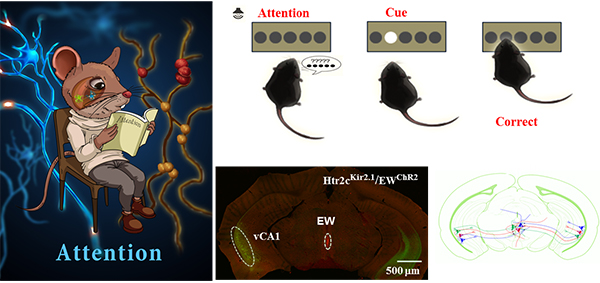Genetically modified virus tracing H129ΔTK was used to determine synaptic targets of Htr2c cells. AAV-ChR2 was used to determine whether synaptic connections between Htr2c cells and EW cells are functional.
The viruses used in this article are in the table below
|
Herpes simplex virus type 1 strain 129 |
H129ΔTK-mCherry
H129ΔTK-GFP |
|
Tracing Helper |
rAAV1/2-DIO-TVA/G |
|
Optogenetic |
rAAV1/2-DIO-ChR2-mCherry
rAAV1/2-DIO-Kir2.1-IRES-ChR2-mCherry
rAAV1/2-DIO-GFP-IRES-ChR2-mCherry |
Xinyan Li, Wenting Chen, Kai Pan, Hao Li, Pei Pang, Yu Guo, Shu Shu, You Cai, Lei Pei, Dan Liu, Henok Kessete Afewerky, Qing Tian, Ling-Qiang Zhu and Youming Lu
Pub Date: 2018-08-13,
DOI: 10.1038/s41593-018-0207-0,
Email: sales@brainvta.com
The hippocampus is divided into dorsal and ventral zones along its principal axis. The dorsal hippocampus is critical for learning and memory, yet the basic function of the ventral hippocampus remains elusive. Here we genetically manipulate a subset of excitatory neurons expressing the serotonin receptor 2c (Htr2c) in the ventral hippocampus. Genetically modified virus tracing reveals that these Htr2c cells establish monosynaptic excitatory connections with newly identified neurons in the Edinger–Westphal nucleus (EW), which directly innervate the medial prefrontal cortex. Inactivation of Htr2c cells impairs behavioral performance in a visual-detection task that demands attention, without affecting novel-object recognition, learning, or memory. This attention deficit was recapitulated by inhibition of EW cells and rescued by activation of EW cells or synaptic projections from Htr2c cells onto EW cells. This study uncovers a synaptic pathway for control of attention.

Figure. 1 Htr2c cells directly innervate EW cells.
In this article, the authors have investigated the functions and synaptic circuits of Htr2c cells in the CA1 region of the ventral hippocampus (vCA1) by generating a mutant strain of mice. Combined with genetically modified virus tracing and behavioral screening studies, they have demonstrated that Htr2c cells act as a cellular substrate of attention via direct innervation of EW cells.
BrainVTA offers viral vector construction & virus packaging services for AAV, LV, RABV, PRV, HSV and VSV that help researchers explore questions about genes, neurons, circuitry structure, function of brain network, mechanism and treatment of diseases.
If you have any needs, just email us at
sales@brainvta.com.

